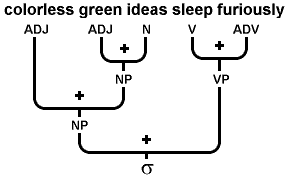Colorless green ideas sleep furiously
|
|

Colorless green ideas sleep furiously is a sentence composed by Noam Chomsky in 1957 as an example of a sentence whose grammar is correct but whose meaning is nonsensical. The phrase suggests that grammar is not the fundamental structure underlying language, as was thought at the time. It indicates that words are symbols with associated properties that will not function if they are not used in the proper semantic context. By demonstrating that "meaning" is not dependent on the grammar of each localized language or culture, Chomsky's work established the theoretical basis for machine translation and generative grammar (the study of a "species-innate" cognitive structure that underlies language development).
Meaninglessness
The central function of the sentence is ideas sleep. Though in some cases it may be valid, in common use "sleep" is never a property of the noun "ideas". Also, both of ideas' adjectives (colorless, green) in the noun phrase (NP) are unlikely properties for the noun —a number of adjectives (bright, dumb, smart, valid) can refer to "ideas", but neither "colorless" nor "green" qualify. Though any adjective can satisfy the general grammatical requirements, only a small number of words will be meaningful.
Furthermore, the two adjectives contradict: "green" is negated by "colorless", and, because word order is often irrelevant within a noun phrase, "colorless" is also negated by "green". This contradiction represents a violation of a fundamental law of cognitive reasoning, and a listener will by deduction understand that the next words in the sentence will likely be impossible to interpret. Finally, while "sleep" is a verb, there is virtually no conceivable case in which "furiously" can meaningfully modify "sleep".
The essential point is that, though words may follow a valid grammatical structure, they cannot form a meaningful sentence, or be a part of a meaningful phrase, if they violate their defined contexts. These contexts play an important role in the initial forming of logical sentences. As each word is simply a symbolic container for both greater and smaller contexts, the underlying structure by which these containers are organized, has important bearing on how they are composed to form sentences. Chomsky went on to explain that this underlying structure (of which the definition is a component) is more important than the grammar, when meaning is communicated: Sentences with the proper symbolic containers (words) may often be recomposed with more useful (for those listening) grammatical structure—but meaningless sentences, regardless if they have proper grammar, are hopelessly lost for meaning.
This phrase can have legitimate meaning to English-Spanish bilinguals, for whom there are double-entendres about the words green (meaning "newly-formed") and sleep (used as a verb of nonexpression). An equivalent sentence in English would be "Newly formed bland ideas are unexpressible in an infuriating way."
Other examples
The results have also been published (http://www.linguistlist.org/issues/2/2-457.html#2) of a 1985 literary competition in which the contestants attempted to make Chomsky's sentence meaningful using not more than 100 words of prose or 14 lines of verse.
There is at least one earlier example of such a sentence, and probably many more. The pioneering (yet mostly forgotten) French syntactician Lucien Tesnière came up with the French sentence "Le silence vertébral indispose la voile licite" ("The vertebrate silence worries the legal sail") to make essentially the same point in his 1954 book (which was mostly written in the late 1930s), the Estonian writer Eduard Vilde (1865-1933) wrote "Rabbits were running to the Eternity holding rainpipes in their mouths", etc.
There are doubtless earlier examples of such sentences, possibly from the philosophy of language literature, but not necessarily uncontroversial ones, given that the focus has been mostly on borderline cases. For example, followers of logical positivism held that "metaphysical" (i.e. not empirically verifiable) statements are simply meaningless; e.g. Rudolph Carnap wrote an article where he quite literally claimed that almost every sentence from Heidegger was grammatically correct, yet meaningless. Of course, non-logical positivists disagreed with this.
The philosopher Bertrand Russell used the sentence "Quadruplicity drinks procrastination" to make a similar point; W.V. Quine took issue with him (and would analogously have disagreed with Chomsky), on the grounds that for a sentence to be false is nothing more than for it not to be true; and since quadruplicity doesn't drink anything, the sentence is simply false, not meaningless.
Examples like Tesnière's and Chomsky's are the least controversially nonsensical, and Chomsky's example remains by far the most famous.
John Hollander wrote a poem titled "Coiled Alizarine" (http://web.mit.edu/24.900/www/poem.html) in his book, The Night Mirror. It ends with Chomsky's sentence.
Reactions towards the notion of meaninglessness
Many functionalist linguists and cognitive linguists, most notably Dwight Bolinger, George Lakoff, Talmy Givón, William A. Croft and M.A.K. Halliday, have argued against the notion of meaninglessness in language, pointing to the fact that the purpose of language is communication; that is, the exchange of meanings. One of their arguments is that, while sentences like 'colorless green ideas sleep furiously' may be possible, they hardly ever appear in naturally occurring language.
